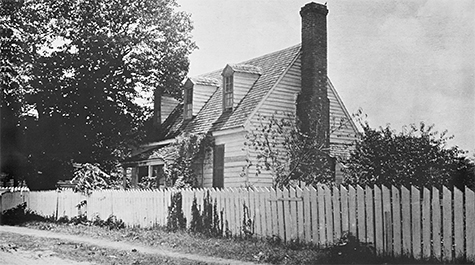Colonial Williamsburg joins William & Mary to research, relocate, interpret 18th-century Bray School for enslaved and free Black children
A small white building that sits tucked away on the William & Mary campus once held an 18th-century school dedicated to the religious education of enslaved and free Black children, researchers have determined.
Now, the university and its neighbor, the Colonial Williamsburg Foundation, are working together to ensure future generations learn about the history of the building and the stories of those who were part of it.
William & Mary and Colonial Williamsburg have forged a partnership regarding the future use of the building, now known as the Bray-Digges House, likely the oldest extant building in the U.S. dedicated to the education of Black children. The agreement calls for relocation of the structure to Colonial Williamsburg’s Historic Area, where it would become the 89th original structure restored by the foundation.
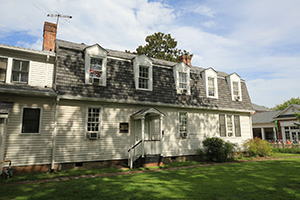 The partnership also establishes the Williamsburg Bray School Initiative, a joint venture of the two institutions to use the Bray School as a focal point for research, scholarship and dialogue regarding the interconnected, often troubled, legacy of race, religion and education in Williamsburg and in America.
The partnership also establishes the Williamsburg Bray School Initiative, a joint venture of the two institutions to use the Bray School as a focal point for research, scholarship and dialogue regarding the interconnected, often troubled, legacy of race, religion and education in Williamsburg and in America.
Research conducted in 2020 by Colonial Williamsburg connected the final dots in a decades-long trail of evidence begun by a curious William & Mary literature professor. The work, focused on dendrochronology of the building’s timber framing, further corroborated research indicating that the building at 524 Prince George St. in Williamsburg once held the Bray School, an institution that educated many of the town’s Black children from 1760 to 1774.
Virginia Gov. Ralph Northam is scheduled to join the Williamsburg community for a special event at 5 p.m. Thursday commemorating the history of the Bray School, its rediscovery and plans for site and interpretation. Due to COVID-19 guidelines, the event is not open to the general public to attend in person but it will be available virtually via live stream.
“It is hard to overstate the importance of this discovery, of the robust history that will be uncovered through this partnership between William & Mary and Colonial Williamsburg” said William & Mary President Katherine A. Rowe. “So much of our history as a nation has gone unrecorded – the history of African Americans, their oppression and resistance. By studying the legacy of the Bray School students, we will uncover and illuminate some of the most important impacts of education in the story of America.”
{{youtube:large|qEeUGQdlot8, Virginia Gov. Ralph Northam joined the Williamsburg community for a special event on Feb. 25 commemorating the history of the Bray School.}}
Generating private financial support
Both partners are generating private financial support for the Williamsburg Bray School Initiative. Colonial Williamsburg’s work to restore and interpret the Bray School’s historic structure is possible in part thanks to a grant of $400,000 from the Gladys and Franklin Clark Foundation.
The grant from the Clark Foundation will allow Colonial Williamsburg to relocate the structure to the Historic Area, and additional funds will be raised to complete the restoration and interpretive work. Cliff Fleet, president and CEO of Colonial Williamsburg, said the project is a critical step toward fostering a broader understanding of Americans’ shared history.
 “Colonial Williamsburg and William & Mary’s partnership to research, restore and interpret the original structure of the Bray School is critical to our ongoing work to uncover our common past and expand our understanding of America’s founding,” said Fleet. “We’re very grateful to the Clark Foundation, whose generous support makes this effort possible. We invite guests, the community and the nation to join us as we continue to pursue and present a more complete story of all who lived in Williamsburg during the Revolutionary era.”
“Colonial Williamsburg and William & Mary’s partnership to research, restore and interpret the original structure of the Bray School is critical to our ongoing work to uncover our common past and expand our understanding of America’s founding,” said Fleet. “We’re very grateful to the Clark Foundation, whose generous support makes this effort possible. We invite guests, the community and the nation to join us as we continue to pursue and present a more complete story of all who lived in Williamsburg during the Revolutionary era.”
Each of the students of the Bray School was taught to read and possibly to write as well as elements of “deportment,” while girls received needlework lessons, all in the furtherance of a Christian education.
Colonial Williamsburg’s Historic Area would be the third location for the venerable structure. The Bray-Digges building originally stood near the corner of Prince George and North Boundary streets. It was moved down Prince George a few hundred yards in 1930 to make way for the construction of Brown Hall, a William & Mary residence hall that’s still in use.
Facing up to a history of enslaving
A Virginia Department of Historic Resources marker commemorating the school was unveiled at Brown Hall in early 2019, and Rowe noted that the new joint venture aligns with other William & Mary initiatives that address the institution’s historical involvement with slavery.
Construction is to begin this year on Hearth: Memorial to the Enslaved, a monument dedicated to the enslaved individuals who labored at William & Mary, while the Lemon Project is a scholarly and educational initiative that investigates slavery and its legacies— and particularly William & Mary’s involvement. The Lemon Project takes its name from Lemon, an enslaved worker at William & Mary.
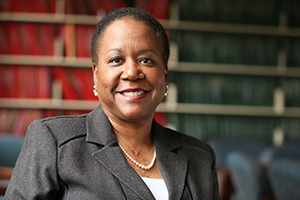 Jody Allen, the Robert Francis Engs Director of the Lemon Project, explained that the Bray School legacy has long been a part of the Lemon Project’s programming. Identification and engagement of descendants of Bray School scholars are among the priorities of the Williamsburg Bray School Initiative.
Jody Allen, the Robert Francis Engs Director of the Lemon Project, explained that the Bray School legacy has long been a part of the Lemon Project’s programming. Identification and engagement of descendants of Bray School scholars are among the priorities of the Williamsburg Bray School Initiative.
Gov. Northam recently appointed Allen to Virginia’s Commission to Study Slavery and Subsequent De Jure and De Facto Racial and Economic Discrimination. She said she expects the Bray School Initiative will allow scholars to follow more closely the intriguing line of evidence of a Bray School education having influence that is deep and wide among Williamsburg’s African American population.
“When we talk about the history of slavery and the history of the African American experience at William & Mary, we include the Bray School,” she said. “We believe the Bray School not only impacted the children who actually attended the school, but it impacted their descendants. We believe very strongly that they went on to share their knowledge with brothers, sisters, neighbors.”
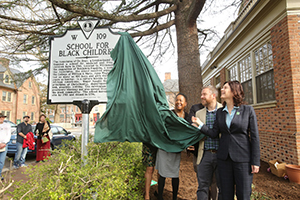 William & Mary and Colonial Williamsburg are neighbors, and collaborations are frequent. The Bray School has been the object of numerous research initiatives focusing on archival as well as material-culture sources aimed at expanding the collective understanding of our shared history.
William & Mary and Colonial Williamsburg are neighbors, and collaborations are frequent. The Bray School has been the object of numerous research initiatives focusing on archival as well as material-culture sources aimed at expanding the collective understanding of our shared history.
Several summer archaeological field schools at Brown Hall were staffed largely by W&M students and led by Mark Kostro, then a Colonial Williamsburg archaeologist and also a graduate student in the university’s Department of Anthropology.
Currently, the university and foundation are partners in work led by the city’s Historic First Baptist Church to research and interpret its first permanent site on South Nassau Street. The Williamsburg Bray School Initiative is designed to channel and intensify such collaborations, facilitating continued research and interpretation, toward a deeper examination of a number of aspects of history through the lens of the Bray School.
“Our knowledge of history is not static; it continues to reveal itself through critical work like the investigation of the Digges house,” said Stephen Seals, Colonial Williamsburg interpreter, program development manager and community liaison. “Restoration and interpretation of the Bray School, which represents another complex chapter in our nation’s story, will be critical to our community’s work to foster a more complete understanding of our shared history.”
A scholar and an interpreter
Nicole Brown, a graduate student in William & Mary’s American Studies Program, is also a Colonial Williamsburg actor-interpreter portraying Ann Wager, a white teacher at the Williamsburg Bray School. She is currently studying the history and impact of the Bray Schools in Williamsburg and beyond. Her work with Colonial Williamsburg is supported by the Mary and Donald Gonzales Field Experience Fund.
Brown’s work as a scholar-interpreter took her to Oxford’s Weston Library where she dove into some 8,000 pages of records of the Associates of Dr. Bray, the London organization that established or tried to establish Bray Schools throughout the New World — in Philadelphia, Nova Scotia and the Bahamas.
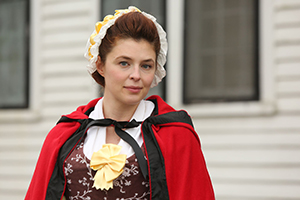 Existing records of the Williamsburg Bray School indicate that the student body was about 90 percent enslaved, with the remainder being free children of color. Ages ranged from 3 to 10 years old, usually equally divided among boys and girls, and the enrollment was around 30.
Existing records of the Williamsburg Bray School indicate that the student body was about 90 percent enslaved, with the remainder being free children of color. Ages ranged from 3 to 10 years old, usually equally divided among boys and girls, and the enrollment was around 30.
Brown said Wager’s funding from the Bray Associates was contingent on the school’s maintaining an enrollment as close to 30 as possible. Brown’s research also led her to dig up and read as many of the Bray School textbooks as she could find.
“Research on the textbooks gave me a great deal of insight into Ann Wager and her students. You can learn a lot based on the books she used at the school,” Brown said. “Quite frankly, you learn a lot about the pro-slavery ideology of the school, when you see how many of the books are extremely rooted in systemic racism.”
Another scholar of the Bray School’s history is Julie Richter, a lecturer in William & Mary’s Department of History and the director of the National Institute of American History & Democracy (NIAHD), itself a partnership of William & Mary and Colonial Williamsburg. She has done research into the students at the Bray School. Known records are far from complete, she said.
Richter said that from the 14-year run of the Williamsburg Bray School, there are surviving student lists from only three years: 1762, 1765 and 1769. The lists, she said, were compiled by Bray School trustee Robert Carter Nicholas, who was Williamsburg’s chief correspondent with the Bray Associates in London.
“I’m eternally optimistic that there will be a few more lists that someone will find in time,” Richter said. “But right now, we have these three slices in time to try to tease out what students were at the school and who sent them.”
Possible motivation of the slaveowners
Brown and Richter said slaveowners had varied motivations for enrolling enslaved children in the Bray School. A demonstrated degree of numeracy and literacy increased the auction value of any enslaved individual, while Brown pointed out that a Bray School education increased a person’s usefulness to a slaveowner, especially one who operated a commercial establishment.
Some 40 percent of the white slaveowners who sent students to the Bray School were women, Brown said, a group that included city tavern owners Christiana Campbell and Jane Vobe.
“If you had an enslaved cook that could read, you could just give her a written recipe,” Brown said. “You wouldn’t have to sit and read it out.”
Richter became interested in probing the three student lists for clues about the motivation among prominent households for educating enslaved children. She said the three lists showed that the John Blair family sent a number of enslaved children to the Bray School. John Blair was the nephew of William & Mary founder James Blair, and a prominent public figure in colonial Virginia in his own right.
“From those three lists, John Blair and his family sent the greatest number of children to the Bray School,” Richter said. “And you can follow some of these Bray students 30 to 40 years after they left school — and they were still with the Blair family.”
Richter said the motivation to educate enslaved children was more complicated for the Blairs and similarly prominent, politically well-connected families than it was among the tradespeople of Williamsburg.
“Some wanted to groom enslaved children to become body servants, personal attendants for various members of the white Blair family,” Richter said. “It shows your status.”
A curious professor finds the first dots
Dendrochronology allowed Colonial Williamsburg researchers to connect the most recent dots of the Bray-Digges link, but the first dots were unearthed and connected by Terry Meyers, Chancellor Professor of English, Emeritus, at William & Mary, who developed an interest in Williamsburg history after moving here in 1970.
Meyers said he was reading a memoir by a local resident when he came across a reference to an 18th-century cottage that in 1930 had been moved down Prince George Street from the corner of Prince George and North Boundary streets.
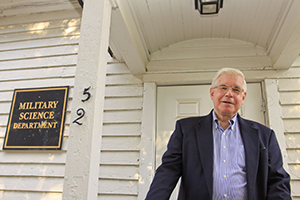
“I walked over to Prince George Street and walked up and down,” Meyers said. “I was looking for an 18th-century structure, and I just couldn’t see it.”
He said he was ready to give up the search, but something prompted him to drop in at Colonial Williamsburg’s John D. Rockefeller Jr. Library, where there was a file on the building.
“From that, I was able to go back and look at what is now 524 Prince George St.,” Meyers said. “And I realized that if you look at that structure and erase the two additions on the right and the left and change the roofline from a Dutch colonial roof to a proper cottage roof, you actually do have an 18th-century cottage.”
It’s remarkable that this particular cottage survived the 18th century, let alone into the 21st, said Ronald Hurst, vice president for museums, preservation and historic resources at Colonial Williamsburg. Hurst led a team of researchers investigating the 18th-century portion of the building this past summer. Their examination included a partial removal of siding and other explorations beneath the updated fabric.
They discovered the reconfigured roof line that Meyers had noticed and a window sash that dates to the original construction date, pinpointed though dendrochronology — tree growth ring dating.
“Our analysis of the structure’s oldest elements conclusively places the timber’s harvest between the winter of 1759-60 and the spring of 1760, with the establishment of the Williamsburg Bray School in 1760,” said Matt Webster, Colonial Williamsburg’s executive director of architectural preservation and research. “That, combined with existing evidence of the Bray School’s historical location on Prince George Street, makes a compelling case that this is the original structure, and the building still has a great deal more to teach us.”
A ‘quick and dirty structure’
Hurst described the 18th-century portion that held the Bray School as a three-bay, story-and-a-half building. There were two rooms that extended the length of the building with a center passage. Each of the two rooms was heated with a fireplace, Hurst added, and one of the original brick chimneys is still there. The half-story had two rooms, with dormer windows, under an A-frame roof. He said there were other revelations from the 2020 work, as well.
“The building was extremely poorly constructed,” Hurst said. “We discovered in getting into the walls that even the standard mortise-and-tenon construction that we expect on outbuildings was abandoned here. And the frame was simply toenailed together. That’s telling us that this was put up as a pretty quick-and-dirty structure.”
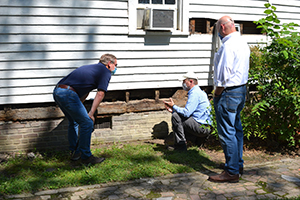 Meyers found that the Bray School operated in the Digges building from its 1760 founding until 1765, when the school moved, possibly out to Capitol Landing Road. He also found William & Mary connections to the Bray School. The 1769 list of children mentioned Adam and Fanny, belonging to the College, and the school figured in faculty minutes from 1773.
Meyers found that the Bray School operated in the Digges building from its 1760 founding until 1765, when the school moved, possibly out to Capitol Landing Road. He also found William & Mary connections to the Bray School. The 1769 list of children mentioned Adam and Fanny, belonging to the College, and the school figured in faculty minutes from 1773.
“I noticed an entry where the faculty had voted to send four loads of firewood to Mrs. Wager, the teacher at the Bray School, because she’d been taking care of children owned by the College,” Meyers said.
The entries about children deepened his interest, he said, and made him want to explore any other William & Mary-Bray School connections.
“I knew in the abstract, that as an old Southern school we must have been involved in some way with slavery, but I'd never really thought much about it until I came across Adam and Fanny,” Meyers said. “Then, the idea that I work for an institution that actually claimed to ‘own’ people — owned children! — you know, got me interested. I think that was one of the seeds that turned into the Lemon Project.”
He found “a wonderful collection of published correspondence” among the Bray Associates, where he found records of Benjamin Franklin’s becoming a member in 1760. Franklin had visited Williamsburg in 1756 and was awarded an honorary degree from William & Mary.
“They asked Franklin where to start Bray Schools in America,” Meyers said. “And he mentioned Williamsburg.” Meyers thinks Franklin discovered the clerical faculty were already involved in the religious education of local Black residents; and the idea of founding a formal school was already abroad. He added that Franklin likely saw the affiliation with William & Mary as a way of protecting the school from its many skeptics.
The unintended consequences of education
Meyers said the Bray School’s mission was to impart Christian education to Black children and the strategy was to get enslaved people to accept their position as divinely ordained. This educational philosophy was very much in line with the Virginia clergy’s use of religious education to convince the enslaved to accept their position in the colony’s social hierarchy.
“It wasn’t intended to shake the pillars of slavery or anything like that,” Meyers said. “I mean, the thinking at the time was that if you were a good Christian slave, you knew you were born through God's will to be enslaved. And so you accepted your role and your position.”
But Meyers added that “education is almost invariably subversive.” Like Allen and Brown, he noted evidence that students at the Bray School took their literacy skills back home and spread them around.
“If you are taught to read the Bible,” he said. “you will be able to read other things. Once you educate people, they are better equipped to think critically.”
Scholars are divided on what appears to be a very simple question: Students were taught reading, but was writing a part of the Bray School curriculum?
Answering that simple question soon leads to a need to understand the world shared by the enslaved and the enslaver at a deeper level. The Lemon Project’s Allen explains that masters might be wary of what could happen if enslaved people learned to write.
“The ability to write would certainly open up opportunities,” she said. “And one of those opportunities would be the ability to forge passes, for themselves and for others.”
Allen explained that enslaved workers sometimes carried written authorizations explaining the errand they were sent on, vouching for the legitimacy of their presence in unfamiliar areas.
“There are lots of stories about enslaved people using passes forged by themselves or by another,” she said. Some of the stories ended with the people riding their forged passes all the way to freedom.
“There’s no definitive statement that we can find anywhere that says that they were taught to write,” Allen said. “But the preponderance of evidence shows that many of them learned to write.”
As evidence of writing instruction, both Richter and Allen cite the large number of slate pencil fragments recovered during the archaeological excavations at the Brown Hall site. Allen also notes that the girls’ needlework lessons at the Bray School included writing of a fashion, in the form of embroidering monograms and samplers.
Even if Bray School lessons did not include writing instruction, Allen points out the short intellectual step from reading — deciphering letters arranged into words — to copying the strokes and curves and making your own words.
No date has been set for the relocation of the Bray-Digges building, and Colonial Williamsburg and William & Mary are considering a number of potential sites. The building has been known as Prince George House. It was most recently used as offices for William & Mary’s Department of Military Science, which has been relocated.
There remain nine to ten months of architectural and archaeological examination of the Bray-Digges building by Colonial Williamsburg researchers. Hurst added that all additional work on the structure will require extra care, especially if it’s to be moved.
“The building’s pretty fragile at this point,” Hurst said. “There’s a good possibility that the plaster and lath are actually helping to hold it together.”














